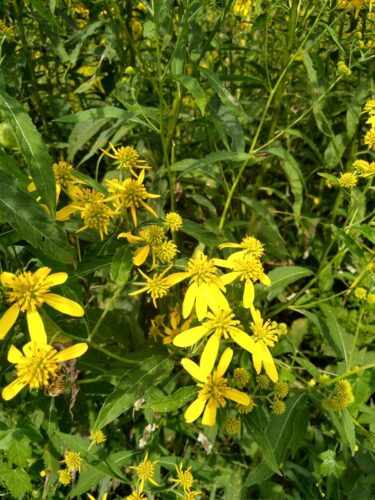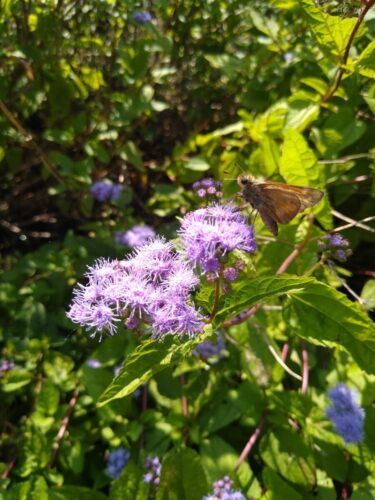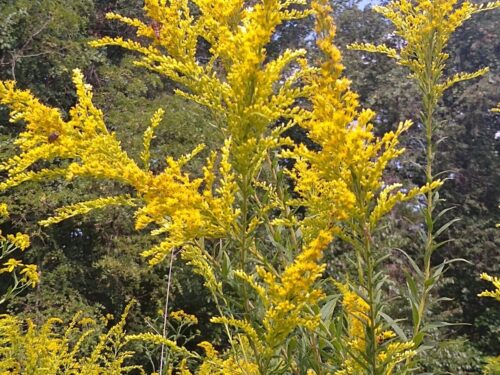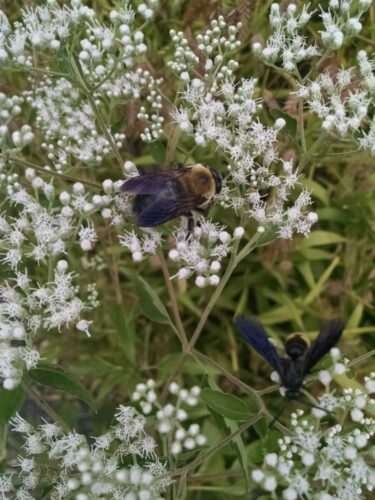Autumn = Asteraceae!
September 10, 2021 3:26 pm

By Ellen Powell, DOF Conservation Education Coordinator
Virginia’s forests in fall are showstoppers, dazzling us with their vibrant colors. But my eyes are often drawn to the weedy roadside ditches and field edges, where fall wildflowers paint the landscape in an Impressionist haze.
Fall-blooming flowers aren’t just for looks. They provide an important late-season food source for bees, wasps, butterflies, and other pollinators. Keeping these insects fed and happy is a big deal, when you consider that 35 percent of the plant foods we consume are pollinated by insects.
Almost all of my fall-blooming favorites belong to the enormous family of Asteraceae. Its former name was Compositae, referring to the composite structure of the blooms. The flowers are clustered into dense heads of many small flowers, with scale-like bracts below the head that often give the whole thing the appearance of one large flower. Members of the Asteraceae family are easily identified by genus, but many are notoriously difficult to identify to the species level. In fact, amateur botanists often lump a whole slew of plants under the unofficial name of “[darned] yellow composites.”
Shades of golden yellow are indeed quite common among fall bloomers. This color may look quite different to pollinators, appearing blue or white. These insects can see the ultraviolet part of the spectrum. Many of these flowers, when viewed under UV light, actually have a pattern we cannot see – like runways leading insects to the target of nectar and pollen-producing parts.
Here are some of the Asteraceae family members you might see along Virginia’s roadways in September and October.
Goldenrods (Solidago species) are a highlight of the season for me. Have you heard people complain that they are allergic to goldenrod? These lovely plants are unfairly blamed for the sneezes of fall, but – surprise! – they’re not particularly allergenic. As noted above, yellow flowers attract insects to carry their pollen away, rather than letting the wind blow it all over the place. The allergen culprit blooming alongside goldenrod is most often ragweed (Ambrosia artemisiifolia). Its flowers are all but unnoticeable, but they pack a punch as one of the most common hay-fever triggers.
- Goldenrod? Not allergenic
- Ragweed? Ahhhh-choo!
Repeating the yellow-gold theme along fall roadsides are tickseeds (Bidens spp.), sunflowers (Helianthus spp.), and wingstem (Verbesina alternifolia). Here in the Charlottesville area, wingstem dominates field edges in September. As with many species in Asteraceae, what appears to be a single flower is actually a composite of two types. Wingstem’s ray flowers look like petals and are sterile. The tiny disk flowers are fertile (able to be pollinated and produce seeds) but not showy, and they are packed densely together. Picture a sunflower, and you can see how ray and disk flowers are arranged to look like one flower, with the rays attracting and directing insects toward the fertile flowers in the center of the head.

Wingstem
Blues and purples are another sector of the fall color palette, often appearing a bit later. Asters (Symphyotrichum spp.) look like little blue or purple daisies with yellow centers. Ironweed (Vernonia noveboracensis) rises tall from damp spots, its clusters of bright purple blooms looking like fluffy little brushes. Mist flower or wild ageratum (Conoclinum coelestinum) has a pastel color seldom seen in nature – not quite blue, not quite purple. (I call it blurple.)

A skipper visiting mist flower
Certain fall flowers attract more insects than others, even without showy ray flowers. Joe Pye weed (Eutrochium purpureum) is a towering plant with large clusters of tiny pink flowers that butterflies love. I wish my garden had enough moisture to support this plant, but I have to settle for appreciating it in sunny ditches and low meadows. Perhaps no plants are more alive with pollinators than the white-flowered thoroughworts (Eupatorium spp.) They tend to be tall and weedy, but I make room for a few in my garden because they are more entertaining than YouTube. I never get tired of watching the bees and wasps of all sizes that visit the fuzzy white blooms.
- Joe Pye Weed
- Bee and wasp on thoroughwort
As you search for the best autumn foliage this season, keep an eye out for the many wildflowers of Asteraceae – and the insects that love them!
Tags: Fall, Wildflowers
Category: Education, Public Information




